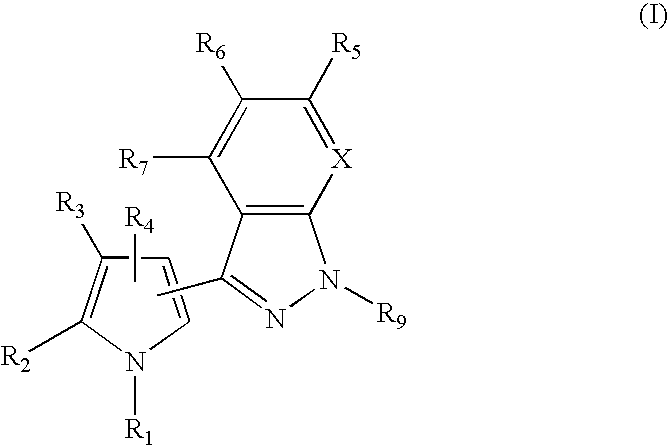3-Pyrrol-pyridopyrazoles and 3-pyrrolyl-indazoles as novel kinase inhibitors
a technology of pyrrolylindazoles and pyrrolylindazoles, which is applied in the direction of metabolism disorders, cell components, cell component details, etc., can solve the problems of compounds that interfere with the signals transduced by such proteins, and achieve the effect of modulating catalytic activity
- Summary
- Abstract
- Description
- Claims
- Application Information
AI Technical Summary
Problems solved by technology
Method used
Image
Examples
example 1
3-(3,5-Dimethyl-1H-pyrrol-2-yl)-1H-pyrazolo[3,4-b]pyridine
[0252]
[0253]2-Chloronicotinoyl chloride (3.4 g, 20 mmol) (Aldrich, Milwaukee, Wis.) was added to a solution of aluminum chloride (2.7 g, 20 mmol) (Aldrich, Milwaukee, Wis.) in dichloromethane (100 mL) at 0° C., followed by a solution of 2,4-dimethylpyrrole (2.9 g, 30 mmol) in dichloromethane (20 mL). The mixture was then stirred at room temperature for one hour. The reaction was diluted with ethyl acetate, washed with brine, dried and concentrated. The residue was purified on a silica gel column to give 2.9 g (62%) of (2-chloro-pyridin-3-yl)-(3,5-dimethyl-1H-pyrrol-2-yl)-methanone.
[0254]A mixture of (2-chloro-pyridin-3-yl)-(3,5-dimethyl-1H-pyrrol-2-yl)-methanone (240 mg, 1 mmol) and hydrazine hydrate (0.7 mL) in ethanol (2 mL) was heated at 100–110° C. for overnight. The reaction was concentrated and purified on a silica gel column to give 97 mg (46%) of the titled compound as a light yellow solid.
[0255]1HNMR (400 MHz, DMSO-d...
example 2
3-(1H-Pyrrol-2-yl)-1H-pyrazolo[3,4-b]pyridine
[0257]
[0258]A solution of 2-chloronicotinoyl chloride (1 eq.) in dichloromethane (10 mL) was added slowly to a mixture of pyrrole (1.5 eq.) (Aldrich, Milwaukee, Wis.) and aluminum chloride (3.5 g, 1 eq.) in dichloromethane (8 mL) at 0° C. The mixture was stirred at 0° C. for 10 mins and at room temperature for 30 mins. The reaction was diluted with ethyl acetate, washed with brine, dried and concentrated. The residue was purified on a silica gel column to give 2.27 g of (2-chloro-pyridin-3-yl)-(1H-pyrrol-2-yl)-methanone.
[0259]A mixture of (2-chloro-pyridin-3-yl)-(1H-pyrrol-2-yl)-methanone (1 g, 4.8 mmol) and hydrazine hydrate (0.5 mL) in ethanol (15 mL) was heated to reflux for overnight. The reaction was concentrated and the residue was triturated with dichloromethane (to remove any unreacted starting material. The solid was filtered, washed wit water and dried to give 720 mg (81%) of the titled compound as a light yellow solid.
[0260]1HN...
example 3
3-(5-Morpholin-4-ylmethyl-1H-pyrrol-2-yl)-1H-pyrazolo[3,4-b]pyridine
[0262]
[0263]Benzyl chloroformate (150 mg) (Aldrich, Milwaukee, Wis.) was added to a mixture of 3-(1H-pyrrol-2-yl)-1H-pyrazolo[3,4-b]pyridine (120 mg) (from Example 2) and triethylamine (3 drops) in dichloromethane (DCM). After stirring at room temperature for one hour, the reaction was concentrated and purified on a silica gel column to give 3-(1H-pyrrol-2-yl)-pyrazolo[3,4-b]pyridine-1-carboxylic acid benzyl ester. It was then combined with di-morpholine methane (300 mg) (Aldrich, Milwaukee, Wis.), THF (2 mL), water (0.2 mL) and acetic acid (2 drops). The mixture was heated at 90° C. for 20 hours. The reaction was concentrated and purified on a silica gel column to give 30 mg of the titled compound as a white solid.
[0264]1HNMR (400 MHz, DMSO-d6) δ 13.44 (s, 1H, NH), 11.24 (s, 1H, NH), 8.50 (d, J=3 Hz, 1H), 8.45 (d, J=8 Hz, 1H), 7.19 (m, 1H), 6.68 (s, 1H), 6.02 (s, 1H), 3.54 (m, 4H), 3.48 (s, 2H, CH2), 2.37 (m, 4H).
[...
PUM
| Property | Measurement | Unit |
|---|---|---|
| flow rate | aaaaa | aaaaa |
| temperatures | aaaaa | aaaaa |
| temperatures | aaaaa | aaaaa |
Abstract
Description
Claims
Application Information
 Login to View More
Login to View More - R&D
- Intellectual Property
- Life Sciences
- Materials
- Tech Scout
- Unparalleled Data Quality
- Higher Quality Content
- 60% Fewer Hallucinations
Browse by: Latest US Patents, China's latest patents, Technical Efficacy Thesaurus, Application Domain, Technology Topic, Popular Technical Reports.
© 2025 PatSnap. All rights reserved.Legal|Privacy policy|Modern Slavery Act Transparency Statement|Sitemap|About US| Contact US: help@patsnap.com



